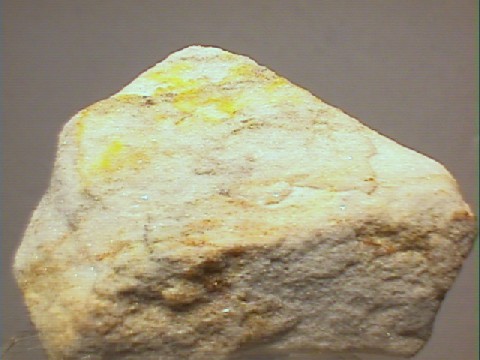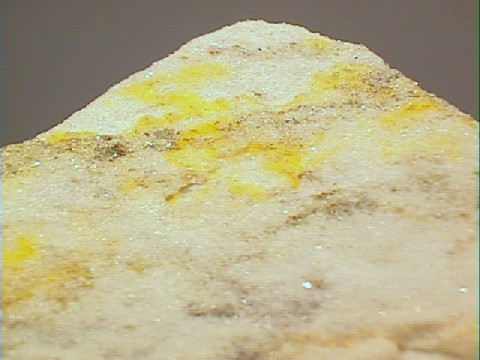 THE MINERAL GREENOCKITE
THE MINERAL GREENOCKITE
- Chemistry: CdS, Cadmium Sulfide
- Class: Sulfides
- Uses: A minor ore of cadmium and as mineral specimens.
Specimens
Greenockite has the same structure as the zinc iron sulfide wurtzite. Greenockite's structure is composed of SCd4 tetrahedrons that are stacked in a layered structure with every other layer exactly the same in an AB AB AB ... hexagonal sequence.
The tetrahedrons in greenockite all are oriented in one direction and produce the hexagonal (six fold rotational) symmetry. The symmetry is broken in a perpendicular direction to the major axis and results in a hemimorphic crystal structure. In other words, there is no symmetry element, like a mirror or two fold rotational axis, perpendicular to the major axis and thus crystal faces on top of the crystal are not repeated on the bottom of the crystal. Hemimorphic crystals have different looking tops from their bottoms, as if they never completed the opposite, symmetrical, side; therefore the term hemimorphic or half shape. Other minerals that have a hemimorphic character are the tourmalines, hemimorphite (obviously), wurtzite and zincite among others.
Crystals of greenockite are typically six sided pyramids where the hemimorphic character is easily seen as the top of the crystal is the point and the bottom of the crystal is the pyramid's base. Often the crystals are platy with a hexagonal outline and the hemimorphic character is then not easily distinguished.
PHYSICAL CHARACTERISTICS:
- Color is honey yellow, orange, red or light to dark brown.
- Luster is adamantine to resinous.
- Transparency crystals are transparent to translucent.
- Crystal System is hexagonal; 6 m m
- Crystal Habits include small tapering hemimorphic six sided pyramids and platy hexagonal crystals. Also seen as crusts or dustings over crystals of calcite, smithsonite and sphalerite.
- Cleavage is poor in one direction (basal) and good in three other directions (prismatic).
- Fracture is conchoidal.
- Hardness is 3 - 3.5
- Specific Gravity is approximately 4.5 - 5 (much heavier than average).
- Streak is red, orange or light brown.
- Other Characteristics: Striations on pyramidal faces parallel to base, an index of refraction of 2.50 - 2.52 and is soluble in hydrochloric acid giving off hydrogen sulfide gas
- Associated Minerals include fluorite, chalcopyrite, quartz, smithsonite, calcite, pyrite, sphalerite, marcasite and prehnite.
- Notable Occurrences include Greenock (hence the name), Scotland; Llallagua, Bolivia; Paterson, New Jersey; Joplin, Missouri; Arkansas, Illinois and Kentucky, USA.
- Best Field Indicators are crystal habit, color, streak and cleavage.



